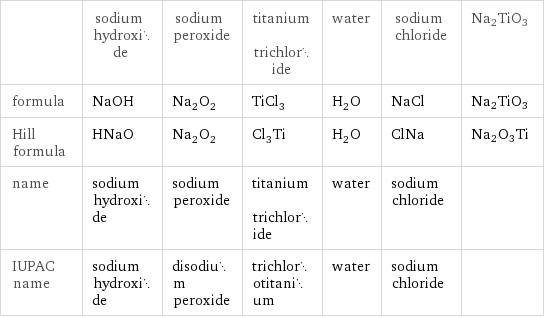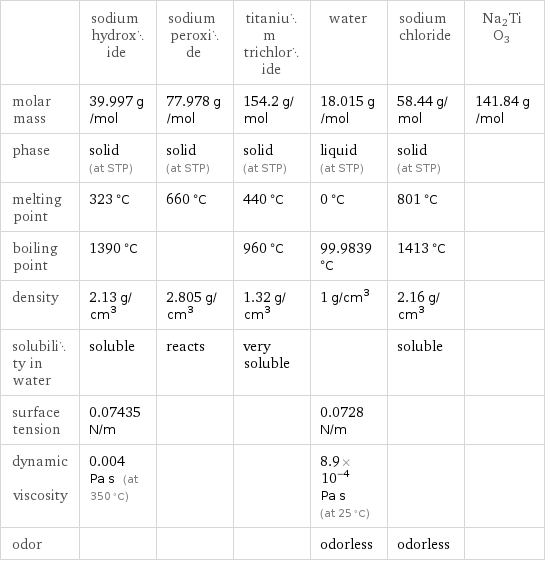Input interpretation

NaOH sodium hydroxide + Na_2O_2 sodium peroxide + TiCl_3 titanium trichloride ⟶ H_2O water + NaCl sodium chloride + Na2TiO3
Balanced equation

Balance the chemical equation algebraically: NaOH + Na_2O_2 + TiCl_3 ⟶ H_2O + NaCl + Na2TiO3 Add stoichiometric coefficients, c_i, to the reactants and products: c_1 NaOH + c_2 Na_2O_2 + c_3 TiCl_3 ⟶ c_4 H_2O + c_5 NaCl + c_6 Na2TiO3 Set the number of atoms in the reactants equal to the number of atoms in the products for H, Na, O, Cl and Ti: H: | c_1 = 2 c_4 Na: | c_1 + 2 c_2 = c_5 + 2 c_6 O: | c_1 + 2 c_2 = c_4 + 3 c_6 Cl: | 3 c_3 = c_5 Ti: | c_3 = c_6 Since the coefficients are relative quantities and underdetermined, choose a coefficient to set arbitrarily. To keep the coefficients small, the arbitrary value is ordinarily one. For instance, set c_2 = 1 and solve the system of equations for the remaining coefficients: c_1 = 8 c_2 = 1 c_3 = 2 c_4 = 4 c_5 = 6 c_6 = 2 Substitute the coefficients into the chemical reaction to obtain the balanced equation: Answer: | | 8 NaOH + Na_2O_2 + 2 TiCl_3 ⟶ 4 H_2O + 6 NaCl + 2 Na2TiO3
Structures

+ + ⟶ + + Na2TiO3
Names

sodium hydroxide + sodium peroxide + titanium trichloride ⟶ water + sodium chloride + Na2TiO3
Equilibrium constant
![Construct the equilibrium constant, K, expression for: NaOH + Na_2O_2 + TiCl_3 ⟶ H_2O + NaCl + Na2TiO3 Plan: • Balance the chemical equation. • Determine the stoichiometric numbers. • Assemble the activity expression for each chemical species. • Use the activity expressions to build the equilibrium constant expression. Write the balanced chemical equation: 8 NaOH + Na_2O_2 + 2 TiCl_3 ⟶ 4 H_2O + 6 NaCl + 2 Na2TiO3 Assign stoichiometric numbers, ν_i, using the stoichiometric coefficients, c_i, from the balanced chemical equation in the following manner: ν_i = -c_i for reactants and ν_i = c_i for products: chemical species | c_i | ν_i NaOH | 8 | -8 Na_2O_2 | 1 | -1 TiCl_3 | 2 | -2 H_2O | 4 | 4 NaCl | 6 | 6 Na2TiO3 | 2 | 2 Assemble the activity expressions accounting for the state of matter and ν_i: chemical species | c_i | ν_i | activity expression NaOH | 8 | -8 | ([NaOH])^(-8) Na_2O_2 | 1 | -1 | ([Na2O2])^(-1) TiCl_3 | 2 | -2 | ([TiCl3])^(-2) H_2O | 4 | 4 | ([H2O])^4 NaCl | 6 | 6 | ([NaCl])^6 Na2TiO3 | 2 | 2 | ([Na2TiO3])^2 The equilibrium constant symbol in the concentration basis is: K_c Mulitply the activity expressions to arrive at the K_c expression: Answer: | | K_c = ([NaOH])^(-8) ([Na2O2])^(-1) ([TiCl3])^(-2) ([H2O])^4 ([NaCl])^6 ([Na2TiO3])^2 = (([H2O])^4 ([NaCl])^6 ([Na2TiO3])^2)/(([NaOH])^8 [Na2O2] ([TiCl3])^2)](../image_source/582a09d0d77dcbb7186787c0f8ccf31a.png)
Construct the equilibrium constant, K, expression for: NaOH + Na_2O_2 + TiCl_3 ⟶ H_2O + NaCl + Na2TiO3 Plan: • Balance the chemical equation. • Determine the stoichiometric numbers. • Assemble the activity expression for each chemical species. • Use the activity expressions to build the equilibrium constant expression. Write the balanced chemical equation: 8 NaOH + Na_2O_2 + 2 TiCl_3 ⟶ 4 H_2O + 6 NaCl + 2 Na2TiO3 Assign stoichiometric numbers, ν_i, using the stoichiometric coefficients, c_i, from the balanced chemical equation in the following manner: ν_i = -c_i for reactants and ν_i = c_i for products: chemical species | c_i | ν_i NaOH | 8 | -8 Na_2O_2 | 1 | -1 TiCl_3 | 2 | -2 H_2O | 4 | 4 NaCl | 6 | 6 Na2TiO3 | 2 | 2 Assemble the activity expressions accounting for the state of matter and ν_i: chemical species | c_i | ν_i | activity expression NaOH | 8 | -8 | ([NaOH])^(-8) Na_2O_2 | 1 | -1 | ([Na2O2])^(-1) TiCl_3 | 2 | -2 | ([TiCl3])^(-2) H_2O | 4 | 4 | ([H2O])^4 NaCl | 6 | 6 | ([NaCl])^6 Na2TiO3 | 2 | 2 | ([Na2TiO3])^2 The equilibrium constant symbol in the concentration basis is: K_c Mulitply the activity expressions to arrive at the K_c expression: Answer: | | K_c = ([NaOH])^(-8) ([Na2O2])^(-1) ([TiCl3])^(-2) ([H2O])^4 ([NaCl])^6 ([Na2TiO3])^2 = (([H2O])^4 ([NaCl])^6 ([Na2TiO3])^2)/(([NaOH])^8 [Na2O2] ([TiCl3])^2)
Rate of reaction
![Construct the rate of reaction expression for: NaOH + Na_2O_2 + TiCl_3 ⟶ H_2O + NaCl + Na2TiO3 Plan: • Balance the chemical equation. • Determine the stoichiometric numbers. • Assemble the rate term for each chemical species. • Write the rate of reaction expression. Write the balanced chemical equation: 8 NaOH + Na_2O_2 + 2 TiCl_3 ⟶ 4 H_2O + 6 NaCl + 2 Na2TiO3 Assign stoichiometric numbers, ν_i, using the stoichiometric coefficients, c_i, from the balanced chemical equation in the following manner: ν_i = -c_i for reactants and ν_i = c_i for products: chemical species | c_i | ν_i NaOH | 8 | -8 Na_2O_2 | 1 | -1 TiCl_3 | 2 | -2 H_2O | 4 | 4 NaCl | 6 | 6 Na2TiO3 | 2 | 2 The rate term for each chemical species, B_i, is 1/ν_i(Δ[B_i])/(Δt) where [B_i] is the amount concentration and t is time: chemical species | c_i | ν_i | rate term NaOH | 8 | -8 | -1/8 (Δ[NaOH])/(Δt) Na_2O_2 | 1 | -1 | -(Δ[Na2O2])/(Δt) TiCl_3 | 2 | -2 | -1/2 (Δ[TiCl3])/(Δt) H_2O | 4 | 4 | 1/4 (Δ[H2O])/(Δt) NaCl | 6 | 6 | 1/6 (Δ[NaCl])/(Δt) Na2TiO3 | 2 | 2 | 1/2 (Δ[Na2TiO3])/(Δt) (for infinitesimal rate of change, replace Δ with d) Set the rate terms equal to each other to arrive at the rate expression: Answer: | | rate = -1/8 (Δ[NaOH])/(Δt) = -(Δ[Na2O2])/(Δt) = -1/2 (Δ[TiCl3])/(Δt) = 1/4 (Δ[H2O])/(Δt) = 1/6 (Δ[NaCl])/(Δt) = 1/2 (Δ[Na2TiO3])/(Δt) (assuming constant volume and no accumulation of intermediates or side products)](../image_source/d251c925cb6617a9b047d6bd59abfcf6.png)
Construct the rate of reaction expression for: NaOH + Na_2O_2 + TiCl_3 ⟶ H_2O + NaCl + Na2TiO3 Plan: • Balance the chemical equation. • Determine the stoichiometric numbers. • Assemble the rate term for each chemical species. • Write the rate of reaction expression. Write the balanced chemical equation: 8 NaOH + Na_2O_2 + 2 TiCl_3 ⟶ 4 H_2O + 6 NaCl + 2 Na2TiO3 Assign stoichiometric numbers, ν_i, using the stoichiometric coefficients, c_i, from the balanced chemical equation in the following manner: ν_i = -c_i for reactants and ν_i = c_i for products: chemical species | c_i | ν_i NaOH | 8 | -8 Na_2O_2 | 1 | -1 TiCl_3 | 2 | -2 H_2O | 4 | 4 NaCl | 6 | 6 Na2TiO3 | 2 | 2 The rate term for each chemical species, B_i, is 1/ν_i(Δ[B_i])/(Δt) where [B_i] is the amount concentration and t is time: chemical species | c_i | ν_i | rate term NaOH | 8 | -8 | -1/8 (Δ[NaOH])/(Δt) Na_2O_2 | 1 | -1 | -(Δ[Na2O2])/(Δt) TiCl_3 | 2 | -2 | -1/2 (Δ[TiCl3])/(Δt) H_2O | 4 | 4 | 1/4 (Δ[H2O])/(Δt) NaCl | 6 | 6 | 1/6 (Δ[NaCl])/(Δt) Na2TiO3 | 2 | 2 | 1/2 (Δ[Na2TiO3])/(Δt) (for infinitesimal rate of change, replace Δ with d) Set the rate terms equal to each other to arrive at the rate expression: Answer: | | rate = -1/8 (Δ[NaOH])/(Δt) = -(Δ[Na2O2])/(Δt) = -1/2 (Δ[TiCl3])/(Δt) = 1/4 (Δ[H2O])/(Δt) = 1/6 (Δ[NaCl])/(Δt) = 1/2 (Δ[Na2TiO3])/(Δt) (assuming constant volume and no accumulation of intermediates or side products)
Chemical names and formulas

| sodium hydroxide | sodium peroxide | titanium trichloride | water | sodium chloride | Na2TiO3 formula | NaOH | Na_2O_2 | TiCl_3 | H_2O | NaCl | Na2TiO3 Hill formula | HNaO | Na_2O_2 | Cl_3Ti | H_2O | ClNa | Na2O3Ti name | sodium hydroxide | sodium peroxide | titanium trichloride | water | sodium chloride | IUPAC name | sodium hydroxide | disodium peroxide | trichlorotitanium | water | sodium chloride |
Substance properties

| sodium hydroxide | sodium peroxide | titanium trichloride | water | sodium chloride | Na2TiO3 molar mass | 39.997 g/mol | 77.978 g/mol | 154.2 g/mol | 18.015 g/mol | 58.44 g/mol | 141.84 g/mol phase | solid (at STP) | solid (at STP) | solid (at STP) | liquid (at STP) | solid (at STP) | melting point | 323 °C | 660 °C | 440 °C | 0 °C | 801 °C | boiling point | 1390 °C | | 960 °C | 99.9839 °C | 1413 °C | density | 2.13 g/cm^3 | 2.805 g/cm^3 | 1.32 g/cm^3 | 1 g/cm^3 | 2.16 g/cm^3 | solubility in water | soluble | reacts | very soluble | | soluble | surface tension | 0.07435 N/m | | | 0.0728 N/m | | dynamic viscosity | 0.004 Pa s (at 350 °C) | | | 8.9×10^-4 Pa s (at 25 °C) | | odor | | | | odorless | odorless |
Units
